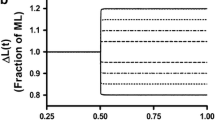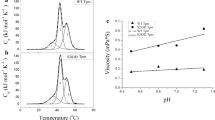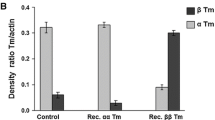Abstract
Protein kinase-A (PKA) is activated during β-adrenergic stimulation of the heart and is known to phosphorylate several sarcomeric proteins including the giant polypeptide titin. A PKA phosphorylation site on titin is located within the N2B-unique sequence, which is present in the elastic segment of the two major isoforms of cardiac titin, N2B and N2BA, but not in the skeletal-muscle isoforms of the N2A-type. In bovine and rat cardiomyocytes, PKA-mediated phosphorylation decreases passive tension (PT), an effect ascribed to titin phosphorylation. Whether titin is phosphorylated by PKA upon β-adrenergic stimulation in human heart has not been shown to date. Here we report that PKA induces phosphorylation of N2B and N2BA titin isoforms, as well as a characteristic proteolytic fragment of titin, T2, in human donor hearts. The PKA-induced phosphorylation signals were stronger when myofilaments were first de-phosphorylated by protein phosphatase-1, suggesting inherent phosphorylation of titin in human heart. Titin phosphorylation was associated with a reduction in PT of skinned human cardiac strips; the relative decrease was higher at shorter than at longer physiological sarcomere lengths. The PKA-dependent PT drop was substantially larger when fibers were pre-treated with protein phosphatase-1, indicating that inherent phosphorylation of titin is important for the basal myocardial PT level. Mechanical measurements on isolated myofibrils from rat heart confirmed the PKA effect on passive stiffness and also showed a more pronounced effect in the presence of reducing agent, DTT. In contrast, PKA did not alter the PT of single skinned rat diaphragm muscle fibers; however, the kinase was still able to phosphorylate the skeletal N2A-titin isoform, which lacks the N2B-unique sequence. Thus, an additional phosphorylation site in titin may exist outside the cardiac N2B-unique sequence. We conclude that PKA mediates phosphorylation of titin in normal human myocardium. Titin phosphorylation lowers titin-based passive stiffness in heart but not in skeletal muscle.
Similar content being viewed by others
References
Bartel S, Morano I, Hunger HD, Katus H, Pask HT, Karczewski P, Krause EG (1994) Cardiac troponin I and tension generation of skinned fibres in the developing rat heart. J Mol Cell Cardiol 26:1123–1131
Bers DM (2006) Cardiac ryanodine receptor phosphorylation: target sites and functional consequences. Biochem J 396:e1–e3
Bers DM, Guo T (2005) Calcium signaling in cardiac ventricular myocytes. Ann N Y Acad Sci 1047:86–98
Borbely A, van der Velden J, Papp Z, Bronzwaer JG, Edes I,␣Stienen GJ, Paulus WJ (2005) Cardiomyocyte stiffness in diastolic heart failure. Circulation 111:774–781
Bullard B, Ferguson C, Minajeva A, Leake MC, Gautel M, Labeit D, Ding L, Labeit S, Horwitz J, Leonard KR, Linke WA (2004) Association of the chaperone alpha-B-crystallin with titin in heart muscle. J Biol Chem: 279:7917–1924
Cazorla O, Szilagyi S, Vignier N, Salazar G, Kramer E, Vassort G, Carrier L, Lacampagne A (2006) Length and protein kinase A modulations of myocytes in cardiac myosin binding protein C-deficient mice. Cardiovasc Res 69:370–380
Fearn LA, Bartoo ML, Myers JA, Pollack GH (1993) An optical fiber transducer for single myofibril force measurement. IEEE Trans Biomed Eng 40:1127–1132
Fentzke RC, Buck SH, Patel JR, Lin H, Wolska BM, Stojanovic MO, Martin AF, Solaro RJ, Moss RL, Leiden JM (1999) Impaired cardiomyocyte relaxation and diastolic function in transgenic mice expressing slow skeletal troponin I in the heart. J Physiol 517:143–157
Freiburg A, Trombitas K, Hell W, Cazorla O, Fougerousse F, Centner T, Kolmerer B, Witt C, Beckmann JS, Gregorio CC, Granzier H, Labeit S (2000) Series of exon-skipping events in the elastic spring region of titin as the structural basis for myofibrillar elastic diversity. Circ Res 86:1114–1121
Fukuda N, Wu Y, Nair P, Granzier HL (2005) Phosphorylation of titin modulates passive stiffness of cardiac muscle in a titin isoform-dependent manner. J Gen Physiol 125:257–271
Gautel M, Leonard K, Labeit S (2001) Phosphorylation of KSP motifs in the C-terminal region of titin in differentiating myoblasts. EMBO J 12:3827–3384
Gomes AV, Harada K, Potter JD (2005) A mutation in the N-terminus of troponin I that is associated with hypertrophic cardiomyopathy affects the Ca(2+)-sensitivity, phosphorylation kinetics and proteolytic susceptibility of troponin. J␣Mol Cell Cardiol 39:754–765
Granzier HL, Labeit S (2004) The giant protein titin: a major player in myocardial mechanics, signaling, and disease. Circ Res 94:284–295
Greaser M (2001) Identification of new repeating motifs in titin. Proteins 43:145–149
Hoh JF, Rossmanith GH, Kwan LJ, Hamilton AM (1988) Adrenaline increases the rate of cycling of crossbridges in rat cardiac muscle as measured by pseudo-random binary noise-modulated perturbation analysis. Circ Res 62:452–461
Kentish JC, McCloskey DT, Layland J, Palmer S, Leiden JM, Martin AF, Solaro RJ (2001) Phosphorylation of troponin I by protein kinase A accelerates relaxation and cross-bridge cycle kinetics in mouse ventricular muscle. Circ Res 88:1059–1065
Kögler H, Rüegg JC (1997) Cardiac contractility: modulation of myofibrillar calcium sensitivity by beta-adrenergic stimulation. Isr J Med Sci 33:1–7
Kranias EG, Solaro RJ (1982) Phosphorylation of troponin I and phospholamban during catecholamine stimulation of rabbit heart. Nature 298:182–184
Krüger M, Kohl T, Linke WA (2006) Developmental changes in passive stiffness and myofilament Ca2+ sensitivity due to titin and troponin-I isoform switching are not critically triggered by birth. Am J Physiol Heart Circ Physiol 291:H496–H506
Kulke M, Fujita-Becker S, Rostkova E, Neagoe C, Labeit D, Manstein DJ, Gautel M, Linke WA (2001) Interaction between PEVK-titin and actin filaments: origin of a viscous force component in cardiac myofibrils. Circ Res 89:874–881
Labeit S, Kolmerer B, Linke WA (1997) The giant protein titin. Emerging roles in physiology and pathophysiology. Circ Res 80:290–294
Lange S, Auerbach D, McLoughlin P, Perriard E, Schafer BW, Perriard JC, Ehler E (2002) Subcellular targeting of metabolic enzymes to titin in heart muscle may be mediated by DRAL/FHL-2. J Cell Sci 115:4925–4936
Leake MC, Grutzner A, Kruger M, Linke WA (2006) Mechanical properties of cardiac titin’s N2B-region by single- molecule atomic force spectroscopy. J Struct Biol April 25, 2006, 10.1016/j.jsb.2006.02.017
Linke WA, Fernandez JM (2002) Cardiac titin: molecular basis of elasticity and cellular contribution to elastic and viscous stiffness components in myocardium. J Muscle Res Cell Motil 23:483–497
Linke WA, Ivemeyer M, Olivieri N, Kolmerer B, Ruegg JC, Labeit S (1996) Towards a molecular understanding of the elasticity of titin. J Mol Biol 261:62–71
Linke WA, Rudy DE, Centner T, Gautel M, Witt C, Labeit S, Gregorio CC (1999) I-band titin in cardiac muscle is a three-element molecular spring and is critical for maintaining thin filament structure. J Cell Biol 146:631–644
Makarenko I, Opitz CA, Leake MC, Neagoe C, Kulke M, Gwathmey JK, del Monte F, Hajjar RJ, Linke WA (2004) Passive stiffness changes caused by upregulation of compliant titin isoforms in human dilated cardiomyopathy hearts. Circ Res 95:708–716
Murphy AM (2006) Heart failure, myocardial stunning, and troponin: a key regulator of the cardiac myofilament. Congest Heart Fail 12:32–38
Neagoe C, Kulke M, delMonte F, Gwathmey JK, deTombe PP, Hajjar RJ, Linke WA (2002) Titin isoform switch in␣ischemic human heart disease. Circulation 106:1333–1341
Neagoe C, Opitz CA, Makarenko I, Linke WA (2003) Gigantic variety: expression patterns of titin isoforms in striated muscles and consequences for myofibrillar passive stiffness. J Muscle Res Cell Motil 24:175–189
Opitz CA, Kulke M, Leake MC, Neagoe C, Hinssen H, Hajjar RJ, Linke WA (2003) Damped elastic recoil of the titin spring in myofibrils of human myocardium. Proc Natl Acad Sci U S A 100:12688–12693
Opitz CA, Linke WA (2005) Plasticity of cardiac titin/connectin in heart development J Muscle Res Cell Motil 26:333–342
Patel JR, Fitzsimons DP, Buck SH, Muthuchamy M, Wieczorek DF, Moss RL (2001) PKA accelerates rate of force development in murine skinned myocardium expressing alpha- or beta-tropomyosin. Am J Physiol Heart Circ Physiol 280:H2732–H2739
Prado LG, Makarenko I, Andresen C, Kruger M, Opitz CA, Linke WA (2005) Isoform diversity of giant proteins in relation to passive and active contractile properties of rabbit skeletal muscles. J Gen Physiol 126:461–480
Rutten EP, Engelen MP, Schols AM, Deutz NE (2005) Skeletal muscle glutamate metabolism in health and disease: state of the art. Curr Opin Clin Nutr Metab Care 8:41–51
Sebestyen MG, Wolff JA, Greaser ML (1995) Characterization of a 5.4 kb cDNA fragment from the Z-line region of rabbit cardiac titin reveals phosphorylation sites for proline- directed kinases. J Cell Sci 108:3029–3037
Somerville LL, Wang K (1988) Sarcomere matrix of striated muscle: in vivo phosphorylation of titin and nebulin in mouse diaphragm muscle. Arch Biochem Biophys 262:118–129
Strang KT, Sweitzer NK, Greaser ML, Moss RL (1994) Beta-adrenergic receptor stimulation increases unloaded shortening velocity of skinned single ventricular myocytes from rats. Circ Res 74:542–549
Sumandea MP, Burkart EM, Kobayashi T, DeTombe PP, Solaro RJ (2004) Molecular and integrated biology of thin filament protein phosphorylation in heart muscle. Ann N Y Acad Sci 1015:39–52
Takano-Ohmuro H, Nakauchi Y, Kimura S, Maruyama K (1992) Autophosphorylation of beta-connectin (titin 2) in vitro. Biochem Biophys Res Commun 183:31–35
van der Velden J, Narolska NA, Lamberts RR, Boontje NM, Borbely A, Zaremba R, Bronzwaer JG, Papp Z, Jaquet K, Paulus WJ, Stienen GJ (2006) Functional effects of protein kinase C-mediated myofilament phosphorylation in human myocardium. Cardiovasc Res 69:876–887
van Heerebeek L, Borbely A, Niessen HW, Bronzwaer JG, van der Velden J, Stienen GJ, Linke WA, Laarman GJ, Paulus WJ (2006) Myocardial structure and function differ in systolic and diastolic heart failure. Circulation 113:1966–1973
Wattanapermpool J, Guo X, Solaro RJ (1995) The unique amino-terminal peptide of cardiac troponin I regulates myofibrillar activity only when it is phosphorylated. J Mol Cell Cardiol 27:1383–1391
Witt CC, Gerull B, Davies MJ, Centner T, Linke WA, Thierfelder L (2001) Hypercontractile properties of cardiac muscle fibers in a knock-in mouse model of cardiac myosin-binding protein-C. J Biol Chem 276:5353–5359
Wolff MR, Buck SH, Stoker SW, Greaser ML, Mentzer RM (1996) Myofibrillar calcium sensitivity of isometric tension is increased in human dilated cardiomyopathies: role of altered beta-adrenergically mediated protein phosphorylation. J␣Clin Invest 98:167–176
Yamasaki R, Wu Y, McNabb M, Greaser M, Labeit S, Granzier H (2002) Protein kinase A phosphorylates titin’s cardiac-specific N2B domain and reduces passive tension in rat cardiac myocytes. Circ Res 90:1181–1188
Zhang R, Zhao J, Mandveno A, Potter JD (1995) Cardiac troponin I phosphorylation increases the rate of cardiac muscle relaxation. Circ Res 76:1028–1035
Zimmermann WH, Schneiderbanger K, Schubert P, Didie M, Munzel F, Heubach JF, Kostin S, Neuhuber WL, Eschenhagen T (2002) Tissue engineering of a differentiated cardiac muscle construct. Circ Res 90:223–230
Acknowledgements
We thank Patrick Lang, Dennis Bein and Pascal Michelis for performing mechanical measurements. We are grateful to Drs. Roger Hajjar, Federica del Monte and Judith Gwathmey (Massachusetts General Hospital, Boston) for the kind gift of human heart tissue. This work was supported by grants from the German Research Foundation (Li 690/7-1, SFB 629 to W.A. Linke).
Author information
Authors and Affiliations
Corresponding author
Rights and permissions
About this article
Cite this article
Krüger, M., Linke, W.A. Protein kinase-A phosphorylates titin in human heart muscle and reduces myofibrillar passive tension. J Muscle Res Cell Motil 27, 435–444 (2006). https://doi.org/10.1007/s10974-006-9090-5
Received:
Accepted:
Published:
Issue Date:
DOI: https://doi.org/10.1007/s10974-006-9090-5




